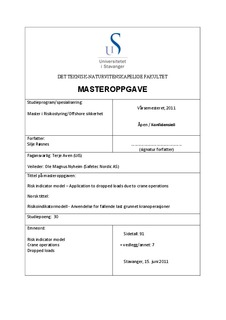| dc.contributor.author | Røsnes, Silje | |
| dc.date.accessioned | 2011-10-10T15:31:56Z | |
| dc.date.available | 2011-10-10T15:31:56Z | |
| dc.date.issued | 2011 | |
| dc.identifier.uri | http://hdl.handle.net/11250/182074 | |
| dc.description | Master's thesis in Risk management | en_US |
| dc.description.abstract | Today crane and lifting operations contribute significantly to the risks in the petroleum industry. They are responsible for a minor percentage of serious injuries, but have a large number of fatalities in relation to unwanted events. Nine out of ten fatal accidents that have occurred during petroleum activities on Norwegian shelf since 1994 have occurred in connection with lifting operations.
There has been recent development in triggering causes for falling loads, this years RNNP report has re-categorized the causes for dropped objects due to crane related operations and there is a need to test models which monitors the risk due to these new causes. One element in monitoring is by measuring a set of risk indicators.
The purpose of the Thesis is to develop and test a risk indicator model for dropped loads due to crane related operations through a literature review and case study. The newly developed MARI model was found to be suitable for this purpose. This is a new area of application for this risk indicator model that should be further explored.
The case study showed a change in risk of dropped objects during offshore operations in different geographical locations in the North Sea and the Barents Sea, and that this could be measured with the developed indicators. Changing the risk level in factors and associated risk indicators in an early phase, pre-condition and planning phase does not necessarily end in an unacceptable high-risk level for the event. If the indicators in the later phases are good and low risk, they reduce the risk transferred on to the event.
These factors were adjusted to have the highest risk through the case study in the Barents Sea:
• Environmental conditions
• Maintenance plan and procedures
• Economy
• Design of Crane
• Regulations
For the location in the North Sea this only applies for environmental conditions and maintenance plan and procedures.
The information in the developed indicators can help monitor risk and be used for several purposes for different groups. Personnel on all levels concerned with the day-to-day operations can use the information as a basis for improvement of their own work. It will increase their knowledge and understanding of the hazards around them. Management can be helped to make informed decisions about risk reducing measures and the effect of these. | en_US |
| dc.language.iso | eng | en_US |
| dc.publisher | University of Stavanger, Norway | en_US |
| dc.relation.ispartofseries | Masteroppgave/UIS-TN-IØRP/2011; | |
| dc.subject | dropped loads | en_US |
| dc.subject | risk indicator model | en_US |
| dc.subject | crane operations | en_US |
| dc.subject | risikostyring | en_US |
| dc.title | Risk indicator model - Application to dropped loads due to crane operations | en_US |
| dc.type | Master thesis | en_US |
| dc.subject.nsi | VDP::Technology: 500 | en_US |
| dc.source.pagenumber | 98 | en_US |
